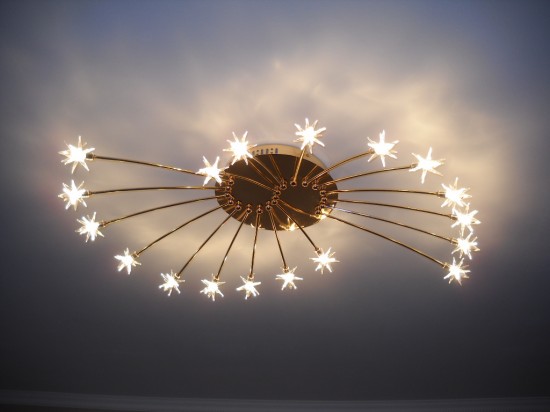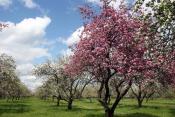Search
Login
Recommended
Lighting apartment. Lighting options for the living room in the interior of a modern apartment, original tips and methods for installing lamps
Light is a powerful tool in the hands of a skilled designer. Thanks to the right lighting, you can increase or decrease the size of the room, create an atmosphere of unique comfort or festivity. Correctly selected lighting should be in all rooms of any house or apartment, but special attention should be paid to how to organize lighting in the living room. Why this is so important, and how to make it modern and original with the help of proper lighting, our article will tell.
Content:
- Living Room Lighting: Features
- Living Room Lighting: Views
- Living room lighting options
- Original lighting sources in the living room video video video
Living Room Lighting: Features
Living room - this is the face of the house, because it is here that we invite friends, guests, here we organize family banquets and feasts, celebrate the New Year or just relax in the family circle after a long working day in front of the TV or even if not quite real, but with a fireplace.

The living room can perform so many functions, moreover, completely fully, and simply not only thanks to well-chosen furniture and the general interior, but also to the right lighting.
We want light and celebration, we turn on the overhead light, built-in lamps or a chic chandelier so that the room becomes more spacious, visually taller and larger, giving the impression of a real banquet hall.

If you need to arrange a festive half-light, such as everything on the same New Year or Valentine's Day, then we add sconce lights, backlighting for bubble panels, built-in backlighting for niches, bright TV screens, and warm flickering of a fireplace to the festive garlands and candles.
And if you just need to rest and relax behind a book or in the company of loved ones, then a pleasant calm light coming from a large built-in aquarium, fireplace or an ordinary floor lamp or even ordinary ceiling lighting, but with the selected color and intensity, according to the mood, the light will be like impossible by the way.

But, in addition to the mood, properly selected and positioned lighting in the living room can functionally emphasize, highlight certain areas: rest, living room; divide the room into completely independent functional parts, if necessary: \u200b\u200ba work area and a rest area; expand the space of the room and emphasize the beauty of decorative objects located in niches, on shelves.

Therefore, proper lighting in the living room is the right interior and the right mood. And in order to create them quickly and simply you need to correctly select and arrange the lighting in the living room.
Living Room Lighting: Views
How can I arrange the light sources in the living room, a matter of taste and functionality of each particular bulb.
But, nevertheless, there are general rules and trends in the organization of lighting both in the living room and in any other room. For example, there are several types of lighting:

- By type of light source: any room provides for the presence of both artificial (light of various lamps and electrical appliances), and daylight (sunlight from the windows).
- According to the degree of coverage of the premises: in any room, and the living room is no exception, availability is provided general and local lighting.

General lighting illuminates the entire room.
Local, highlights, illuminates only that part of the room that is currently being used or should be highlighted, emphasized by its own lighting design.
- By degree of functionality: in any room, and living room this is especially true, you just need to organize not only functional, but also and decorative lighting.
Functional lighting is any lighting whose main purpose is to illuminate a certain space of a room or the whole room.

For decorative purposes, I use the illumination of niches, cornices, shelves, sometimes furniture to effectively highlight and emphasize with light both space and objects. Of course, decorative lighting, nevertheless, lighting, so with several niches with backlighting you can easily create an intimate atmosphere of dusk without the use of wall sconces and floor lamps.
- At the location of the light sources: ceiling (chandeliers) wall (sconces) outdoor (floor lamps and lamps), built-in (various types of lighting, moreover, this is not only the lighting of the ceiling in the living room, but also the lighting of niches, floors, baseboards, etc.). All these types of arrangement of light sources in this modern living room are present, one might say, without fail.
How exactly they are located, what functions they perform, we will consider in more detail on specific examples.
Living room lighting options
Naturally, we will consider options for artificial lighting in the living room. And start from the ceiling.
The ceiling lighting of the living room has several variations:
- General functional lighting with the obligatory presence of a chandelier (and possibly several).


- General functional and decorative recessed lighting (which may include lighting the living room without a chandelier).

Wall lighting is, most often, a local functional and decorative lighting: wall sconces, decorative lamps, niches and wall panels made of glass or onyx with illumination, as well as televisions with neon illumination.



Floor options for lighting the living room are also very diverse - this is local decorative and functional lighting: all types of floor lamps, lights and objects that perform their role, aquariums, bubble panels, electric fireplaces.


Original lighting sources in the living room
Any light source matched to the overall interior is already original in itself.
But sometimes, choosing lighting for the living room, we encounter difficulties: how to make it so much light, different, but the space is not cluttered with unnecessary sconces and lamps?
The output, of course, is simple:
- recessed lighting located in original, non-standard ways


or with the presence of lighting intensity control systems and the ability to select the color of light.
- use of backlight: diode and neon ribbons, which are completely invisible when turned off.
- the use of art objects, which are also fixtures, as wall and floor lighting:




wall panels,

aquariums


waterfalls
and bubble panels with backlight








